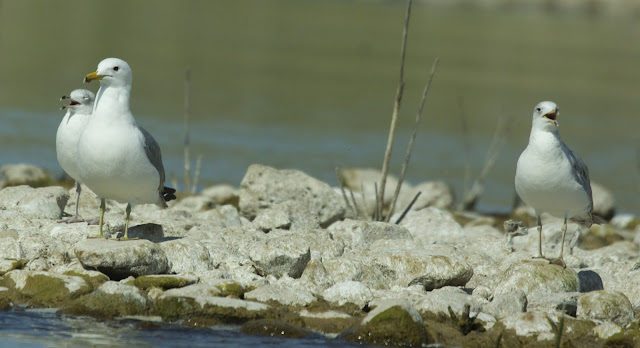For this year's North American Migration Count (NAMC) I headed out to Alamo Lake in La Paz County, about 2 and a half hours outside of Phoenix. Fed by the Big Sandy, Santa Maria, and Bill Williams Rivers, Alamo Lake is a reservoir like many of the others in central Arizona. It's sizable, pleasant, and also a bit sterile. Its ample waters and its lush riparian habitats combine to make some great birding, and some excellent rarities, in the form of Mew and Lesser Black-backed Gulls, already turned up at the lake a few months ago.
As of May 11th, with many of the winterfowl now departed but for a handful of Teal and Mallards, the Western Grebes are now the dominant force on Alamo Lake. It took about two hours to count 274 of them.
Ever elegant, the Western Grebes are always a treat to see, especially with a couple Clark's hidden in the flocks, and they were accompanied by smaller regiments of the not elegant American Coots, and the in-between elegant Eared Grebes.

In the Alamo NAMC waterfowl department, a Common Loon was the highlight, even though it dodged away before I could photograph the thing. I spent a fair portion of time kayaking around the La Paz portion of Alamo Lake. The Western Grebes were problematic on their own, timing their dives and disappearances to perfection. We spotted the Loon while loading into the water, but by the time I was sea-ready it had disappeared, and thus I am still without photos of any Loon species. Only these more static onlookers remained.
It was unreasonable to hope that now, in mid-May, the Lesser Black-backed or Mew Gull would still be around the lake. It was preposterous. It was reckless. It was irresponsible. Just a tiny bit...I hoped anyway. Needless to say, vagrant Gulls of that magnitude were not to be found this time around and this time of year, but towards the end of next winter I will certainly be larus looking at Alamo. In the mean time, I had to make do with the usual stuff--Ring-billed and Franklin's Gulls--plus a nice, full cycle California Gull.

Though eBird flagged it as a rarity, the California Gull didn't come as a great surprise. They sporadically turn up in Phoenix during migratory months, and Alamo Lake matches any of the central Arizona water features. What made this sighting particularly nice was that, after first spotting the Gull on a distant fly-by, it landed pretty close to the kayak, was still on the La Paz side of the lake, and was in a mature plumage, unlike everybody else around him.
It ain't an Ivory Gull, nor even a Black-headed, but hey the state bird of Utah is no slouch. He was the biggest, baddest gull in Alamo, the Davy Crockett, if you will, and he bossed the subservient Ring-bills around quite magnificently.
In case you're wondering, yes, the California Gull is giving the Ring-billed a piggy-back ride. He is a magnanimous and benevolent Gull overlord.
With the great possibility of rarity sighting on the water, kayaking and surveying were great fun. However, the biggest attraction at Alamo Lake is, I think, the massive, thick, jungly riparian habitat in the northeast corner of the lake. To get here by car, one has to backtrack several miles and then take Park Road northwest towards a way station. It's a dusty, onerous drive, but when one finally clears the last hill the verdant expanse is breathtaking. With so many of the standard red and brown, dry cliffs and hills in the area, this strip of green amazes.
Tons and tons of salt cedar, tamarisk, willows, and cottonwoods cram around where three rivers--the Big Sandy, Bill Williams, and Santa Maria--all empty into Alamo Lake. The rivers weren't too high this time, but clearly this riparian area is well-watered.
The Alamo riparian forest didn't yield any Gray Hawks or eastern Warblers, the sort of rare vagrants one might hope for, but Yellow-breatsed Chats, Yellow Warblers, Common Yellowthroats, Bell's and Warbling Vireos, and Tanagers were making a cacophony I've only seen comparably emulated in a grade school cafeteria. With the foliage being so thick, the views weren't actually that great, but it was a great practice is ear-birding and a charming acquaintance with another big riparian tract, Arizona's most precious and fragile habitat.
Since it is relatively remote and, most of all, totally removed from any other attractions that might draw people to it, Alamo Lake is very under-birded. I can't say I'll make it a frequent stop, but certainly pulling through here once a year would a good move.
I have to mention a special thanks to my dad, Larry Butler, for all of his help in surveying through the heat and dust, as well as helping me lug around a bulky kayak and bush-crash through acres of scratchy salt cedar and tamarisk.
It will be very interesting and enjoyable to see all the final findings for La Paz county's NAMC, but one thing I found for sure is another solid birding spot in Arizona.






